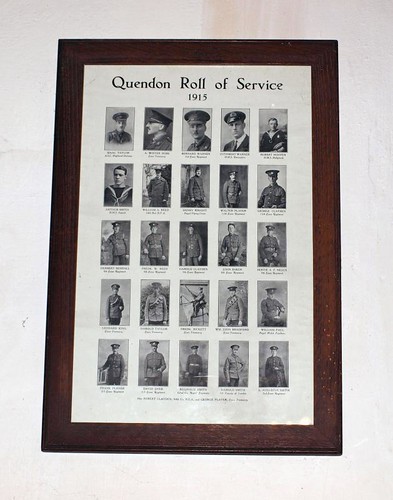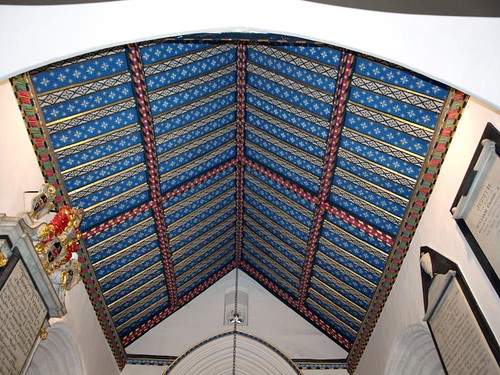I also took the opportunity to re-visit, and record properly, both Newport and Saffron Walden.
CHURCH (dedication unknown). The exterior looks all 1881, the date of the restoration and the rebuilding of the S side. Inside, arcade of three bays, with circular piers and arches with two slight chamfers, i.e. early C13, but also over-restored. - LECTERN. A large standing alabaster angel, 1906. - PLATE. Cup of 1638(?).
QUENDON. It lies by the road to Saffron Walden, which runs in a valley made by a stream flowing to the River Cam. The road winds past a hundred-acre park in which the deer have roamed for centuries, and in it stands the timbered hall of Tudor days, now faced with red and blue bricks. We see it as the 17th century faced it, a handsome place with a front of six bays divided by pilasters which support a charming timbered cornice. In the grounds is an octagonal dovecot with a lead-capped lantern, and on the walls of the attics are remains of painted figures 300 years old.
The old church stands a little above the road, with six gabled windows and two arcades of the 13th century. Two of their fine columns have niches probably used for holding lights. The chancel was made new 400 years ago, but its arch is 13th century. One of the windows is in memory of John Collin, rector here for 60 years last century, and there is another with two angels in memory of a maid-of-honour to Queen Victoria.
Fine pieces of modern craftsmanship are the lectern, on which is an alabaster angel with flowing hair, and the screen given by Sir William Foot Mitchell in memory of his son-in-law; he was Captain Winter Rose, who gave his life for us, and as he lay dying made a thumbnail sketch of what he would like this screen to be. The font is modern, but the medieval font has been rescued from a ditch and is outside the door. There is a beautiful chalice of Charles Stuart’s day in the vestry, where hang two certificates recording burials in wool. From 1621 to 1792 this form of burial is in the register, and among the names of those buried in wool here we found that of Thomas Winstanley, whose son Henry built Eddystone Lighthouse. Henry’s uncle William, who also lies here, was famous in his day for his Poor Robin Almanacs. He also sold chap-books, and was a great character towards the end of the 17th century. He is said to have started as a barber in London, and then to have given up the razor to use the scissors for making up his books and almanacs.
Simon K -
Rickling is a joint parish with Quendon. On the large village green there was a cricket match in progress, the pub doing good business. It looked idyllic. One of the residents of the village is celebrity chef Jamie Oliver, who grew up in neighbouring Clavering.
The road leads down to the A11, the old Norwich and Newmarket to London road, and Rickling becomes Quendon, with bigger houses but much, much more traffic, despite the fact that the M11 also passes through, going under the high street to the north. Madness.
Up an alleyway from the main road is the parish church.
Closed for repair work. The entire west end was under scaffolding and netting. I'd seen this from way back at Rickling, and had hoped it wasn't the church. Interestingly, there is a big house to the west of the church, and the owner until he died in 1995 was Stephen Dykes Bower, architect of, among other things, St Nicholas Great Yarmouth and the new bits of St Edmundsbury Cathedral. This was his hobby church - virtually everything not medieval here is by him.
I took a note of the churchwardens phone numbers so I can find out when they've finished and do this one when I come back to do Newport. And then I was crossing the M11 myself, and after a mile or so on a very steep and not very pleasant lane (it went through a quarry, which fell away on each side), I arrived in the lovely village of Widdington.
The old church stands a little above the road, with six gabled windows and two arcades of the 13th century. Two of their fine columns have niches probably used for holding lights. The chancel was made new 400 years ago, but its arch is 13th century. One of the windows is in memory of John Collin, rector here for 60 years last century, and there is another with two angels in memory of a maid-of-honour to Queen Victoria.
Fine pieces of modern craftsmanship are the lectern, on which is an alabaster angel with flowing hair, and the screen given by Sir William Foot Mitchell in memory of his son-in-law; he was Captain Winter Rose, who gave his life for us, and as he lay dying made a thumbnail sketch of what he would like this screen to be. The font is modern, but the medieval font has been rescued from a ditch and is outside the door. There is a beautiful chalice of Charles Stuart’s day in the vestry, where hang two certificates recording burials in wool. From 1621 to 1792 this form of burial is in the register, and among the names of those buried in wool here we found that of Thomas Winstanley, whose son Henry built Eddystone Lighthouse. Henry’s uncle William, who also lies here, was famous in his day for his Poor Robin Almanacs. He also sold chap-books, and was a great character towards the end of the 17th century. He is said to have started as a barber in London, and then to have given up the razor to use the scissors for making up his books and almanacs.
Simon K -
Rickling is a joint parish with Quendon. On the large village green there was a cricket match in progress, the pub doing good business. It looked idyllic. One of the residents of the village is celebrity chef Jamie Oliver, who grew up in neighbouring Clavering.
The road leads down to the A11, the old Norwich and Newmarket to London road, and Rickling becomes Quendon, with bigger houses but much, much more traffic, despite the fact that the M11 also passes through, going under the high street to the north. Madness.
Up an alleyway from the main road is the parish church.
Closed for repair work. The entire west end was under scaffolding and netting. I'd seen this from way back at Rickling, and had hoped it wasn't the church. Interestingly, there is a big house to the west of the church, and the owner until he died in 1995 was Stephen Dykes Bower, architect of, among other things, St Nicholas Great Yarmouth and the new bits of St Edmundsbury Cathedral. This was his hobby church - virtually everything not medieval here is by him.
I took a note of the churchwardens phone numbers so I can find out when they've finished and do this one when I come back to do Newport. And then I was crossing the M11 myself, and after a mile or so on a very steep and not very pleasant lane (it went through a quarry, which fell away on each side), I arrived in the lovely village of Widdington.



No comments:
Post a Comment